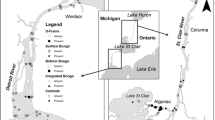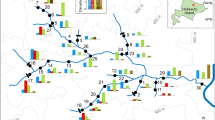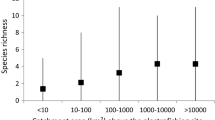Abstract
Vertical hydrological connectivity between the surface stream and benthic and hyporheic zones plays a key ecological role in the biodiversity of lotic ecosystems because it allows surface and benthic organisms to use the hyporheic zone as a seasonal habitat and refuge. Use of the hyporheic zone by surface/benthic organisms has been well studied in invertebrates, but little is known about the importance of this connectivity for fishes. We investigated streambed surface and hyporheic densities (5–10, 15–20 and 20–25 cm below the streambed surface) of a stream fish, Cobitis shikokuensis, over a 20-month period in the Shigenobu River, southwestern Japan, to test the hypothesis that it uses the hyporheic zone for spawning and overwintering. In total, 1,804 individuals (13–58 mm total length) were captured from 33 streambed surface samplings and 102 individuals (10–46 mm total length) were present in 1,147 samples of 57 hyporheic samplings. Population densities in both zones peaked in late summer–early autumn due to the recruitment of age 0+ fish and a female with eggs was found in the hyporheic zone during the reproductive season. Both 0+ and older fish were absent from the streambed surface during winter, and fish densities were also lower in the hyporheic zone at this time. However, the vertical distribution of the fish tended to be skewed towards the deeper hyporheic layers from autumn to spring. These findings indicate that C. shikokuensis vertically migrates between the streambed surface and the hyporheic zone for spawning, rearing and overwintering, suggesting that the integrity of vertical hydrological connectivity in lotic systems is crucial for certain fish species.



Similar content being viewed by others
References
Boulton AJ (2007) Hyporheic rehabilitation in rivers: restoring vertical connectivity. Freshw Biol 52:632–650
Boulton AJ, Findlay S, Marmonier P, Stanley EH, Valett HM (1998) The functional significance of the hyporheic zone in streams and rivers. Annu Rev Ecol Syst 29:59–81
Boulton AJ, Dole-Olivier MJ, Marmonier P (2003) Optimizing a sampling strategy for assessing hyporheic invertebrate biodiversity using the Bou-Rouch method: within-site replication and sample volume. Arch Hydrobiol 156:431–456
Boulton AJ, Datry T, Kasahara T, Mutz M, Stanford JA (2010) Ecology and management of the hyporheic zone: stream–groundwater interactions of running waters and their floodplains. J North Am Benthol Soc 29:26–40
Clinton SM, Grimm NB, Fisher SG (1996) Response of a hyporheic invertebrate assemblage to drying disturbance in a desert stream. J North Am Benthol Soc 15:700–712
Datry T (2012) Benthic and hyporheic invertebrate assemblages along a flow intermittence gradient: effects of duration of dry events. Freshw Biol 57:563–574
Datry T, Larned ST, Scarsbrook MR (2007) Responses of hyporheic invertebrate assemblages to large-scale variation in flow permanence and surface–subsurface exchange. Freshw Biol 52:1452–1462
Davey AJH, Kelly DJ, Biggs BJF (2006) Refuge-use strategies of stream fishes in response to extreme low flows. J Fish Biol 69:1047–1059
Descloux S, Datry T, Marmonier P (2013) Benthic and hyporheic invertebrate assemblages along a gradient of increasing streambed colmation by fine sediment. Aquat Sci 75:493–507
Dole-Olivier M-J (2011) The hyporheic refuge hypothesis reconsidered: a review of hydrological aspects. Mar Freshw Res 62:1281–1302
Dole-Olivier M-J, Maazouzi C, Cellot B, Fiers F, Galassi DMP, Claret C, Martin D, Mérigoux S, Marmonier P (2014) Assessing invertebrate assemblages in the subsurface zone of stream sediments (0–15 cm deep) using a hyporheic sampler. Water Resour Res 50:453–465
Dunn NR, O’Brien LK (2006) Gravel burrowing ability in Galaxias cobitinis. New Zealand Department of Conservation, Wellington
Ehime Prefectural Chuyo Fisheries Experimental Station (1995) Report of conservation project for threatened aquatic organisms in Ehime Prefecture: the spinous loach, Cobitis takatsuensis. Ehime Prefectural Chuyo Fisheries Experimental Station, Iyo
Eliason EJ, Clark TD, Hague MJ, Hanson LM, Gallagher ZS, Jeffries KM, Gale MK, Patterson DA, Hinch SG, Farrell AP (2011) Differences in thermal tolerance among sockeye salmon populations. Science 332:109–112
Fraser BG, Williams DD (1997) Accuracy and precision in sampling hyporheic fauna. Can J Fish Aquat Sci 54:1135–1141
Fujiwara Y, Uchida Y, Kawanishi R, Inoue M (2014) Fish assemblage changes is spring-fed irrigation ponds with reference to revetment construction and exotic piscivorous fish: a comparison with a decade ago. Ecol Civ Eng 16:91–105
Fullerton AH, Burnett KM, Steel EA, Flitcroft RL, Pess GR, Feist BE, Torgersen CE, Miller DJ, Sanderson BL (2010) Hydrological connectivity for riverine fish: measurement challenges and research opportunities. Freshw Biol 55:2215–2237
Heggenes J, Bremset G, Brabrand Å (2013) Visiting the hyporheic zone: young Atlantic salmon move through the substratum. Freshw Biol 58:1720–1728
Hothorn T, Bretz F, Westfall P (2008) Simultaneous inference in general parametric models. Biom J 50:346–363
Jones JI, Murphy JF, Collins AL, Sear DA, Naden PS, Armitage PD (2012) The impact of fine sediment on macro-invertebrates. River Res Appl 28:1055–1071
Jurajda P, Rulík M (2001) Occurrence of stone loach in the hyporheic zone. Folia Zool 50:239–240
Kawanishi R, Inoue M, Dohi R, Fujii A, Miyake Y (2013) The role of the hyporheic zone for a benthic fish in an intermittent river: a refuge, not a graveyard. Aquat Sci 75:425–431
Lake PS (2003) Ecological effects of perturbation by drought in flowing waters. Freshw Biol 48:1161–1172
Malard F, Galassi D, Lafont M, Dolédec S, Ward JV (2003) Longitudinal patterns of invertebrates in the hyporheic zone of a glacial river. Freshw Biol 48:1709–1725
Malcolm IA, Soulsby C, Youngson AF, Hannah DM, McLaren IS, Thorne A (2004) Hydrological influences on hyporheic water quality: implications for salmon egg survival. Hydrol Process 18:1543–1560
Molls F (1999) New insights into the migration and habitat use by bream and white bream in the floodplain of the River Rhine. J Fish Biol 55:1187–1200
Nakajima J, Suzawa Y, Shimizu T, Saitoh K (2012) Proposal of standard Japanese names for Japanese loaches in the genus Cobitis (Cobitidae). Jpn J Ichthyol 59:86–95
Navel S, Mermillod-Blondin F, Montuelle B, Chauvet E, Simon L, Piscart C, Marmonier P (2010) Interactions between fauna and sediment control the breakdown of plant matter in river sediments. Freshw Biol 55:753–766
Opperman JJ, Lohse KA, Brooks C, Kelly NM, Merenlender AM (2005) Influence of land use on fine sediment in salmonid spawning gravels within the Russian River Basin, California. Can J Fish Aquat Sci 62:2740–2751
Orghidan T (1959) Ein neuer Lebensraum des unterirdischen Wassers: der hyporheische Biotop. Arch Hydrobiol 55:392–414
Orghidan T (2010) A new habitat of subsurface waters: the hyporheic biotope. Fundam Appl Limnol 176:291–302
Palmer MA, Bely AE, Berg KE (1992) Response of invertebrates to lotic disturbance: a test of the hyporheic refuge hypothesis. Oecologia 89:182–194
Phillips RW, Claire EW (1966) Intragravel movement of the reticulate sculpin, Cottus perplexus and its potential as a predator on salmonid embryos. Trans Am Fish Soc 95:210–212
Poizat G, Corivelli AJ (1997) Use of seasonally flooded marshes by fish in a Mediterranean wetland: timing and demographic consequences. J Fish Biol 51:106–119
Poole GC, Berman CH (2001) An ecological perspective on in-stream temperature: natural heat dynamics and mechanisms of human-caused thermal degradation. Environ Manag 27:787–802
R Core Team (2014) R: a language and environment for statistical computing. R Foundation for Statistical Computing, Vienna. http://www.R-project.org/. Accessed 10 December 2014
Saint-Paul U, Zuanon J, Correa MAV, García M, Fabré NN, Berger U, Junk WJ (2000) Fish communities in central Amazonian white- and blackwater floodplains. Environ Biol Fishes 57:235–250
Schälchli U (1992) The clogging of coarse gravel river beds by fine sediment. Hydrobiologia 235/236:189–197
Shimizu T (2002) Life history of a Japanese spinous loach, Cobitis takatsuensis, in Shikoku Island. Jpn J Ichthyol 49:33–40
Stegman JL, Minckley WL (1959) Occurrence of three species of fishes in interstices of gravel in an area of subsurface flow. Copeia 1959:341
Stocker ZSJ, Williams DD (1972) A freezing core method for describing the vertical distribution of sediments in a streambed. Limnol Oceanogr 17:136–138
Stubbington R, Boulton AJ, Little S, Wood PJ (2015) Changes in invertebrate assemblage composition in benthic and hyporheic zones during a severe supraseasonal drought. Freshw Sci 34:344–354
Stubbington R, Wood PJ, Reid I (2011) Spatial variability in the hyporheic zone refugium of temporary streams. Aquat Sci 73:499–511
Sutherland AB, Meyer JL, Gardiner EP (2002) Effects of land cover on sediment regime and fish assemblage structure in four southern Appalachian streams. Freshw Biol 47:1791–1805
Suzawa Y (2006) A new loach, Cobitis shikokuensis (Teleostei: Cobitidae), from Shikoku Island, Japan. Ichthyol Res 53:315–322
Tsukamoto K, Aoyama J, Miller MJ (2002) Migration, speciation, and the evolution of diadromy in anguillid eels. Can J Fish Aquat Sci 59:1989–1998
Vadher AN, Stubbington R, Wood PJ (2015) Fine sediment reduces vertical migrations of Gammarus pulex (Crustacea: Amphipoda) in response to surface water loss. Hydrobiologia 753:61–71
Ward JV (1989) The four-dimensional nature of lotic ecosystems. J North Am Benthol Soc 8:2–8
Acknowledgements
We would like to thank H. Okumura, K. Nakashima, H. Nakano, T. Sakai, T. Shimizu, K. Omori and H. Onishi for the development of sampling methods and technical advice, and S. Suekuni, R. Tagashira and Y. Shiota for their assistance in the field. We also thank the two anonymous reviewers for helpful comments that improved the manuscript. This work was supported by the Zoshinkai Fund for the Protection of Endangered Animals, Grants-in-Aid for Japan Society for the Promotion of Science (JSPS) Fellows (23·9280 to R.K.) and for Young Scientists (B) (22710237 to Y.M.) and partly by the Environmental Research and Technology Development Fund (S9) of the Ministry of Environment, Japan. The survey in this study was conducted with the permission of Ehime Prefectural Government and complied with the current laws in Japan.
Author information
Authors and Affiliations
Corresponding author
About this article
Cite this article
Kawanishi, R., Dohi, R., Fujii, A. et al. Vertical migration in streams: seasonal use of the hyporheic zone by the spinous loach Cobitis shikokuensis . Ichthyol Res 64, 433–443 (2017). https://doi.org/10.1007/s10228-017-0576-5
Received:
Revised:
Accepted:
Published:
Issue Date:
DOI: https://doi.org/10.1007/s10228-017-0576-5




